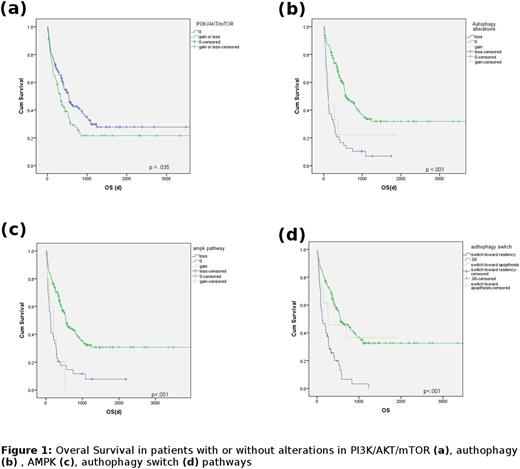Abstract
Introduction
PI3P is a key regulator of cell growth, and mediates cell proliferation via PI3K/AKT/mTOR in response to various growth signals. Abnormal activation of genes in its pathway is associated to oncogenic activity and poor Overall Survival (OS). PI3P is also a core activator of autophagy. Which role autophagy plays in cancer is not well established; it can function as a pro-apoptotic mechanism, or it can improve survive to stresses clearing damaged mitochondria and proteins accumulation, preventing apoptosis. Levels and activity of pro-apoptotic and anti-apoptotic proteins, particularly bcl-2 and p53, membrane signaling via mTOR, high levels of cAMP, a complex made by pink/park, promote a switch from apoptotic autophagy toward a mechanism that augment cell resiliency.
Our study aims to define the role of PI3P pathways in AML, and to establish if autophagy could reduce the patients' chance to respond to induction, and to worsen OS.
Methods
We analyzed 208 consecutive newly diagnosed non M3 AML patients, screened for TP53, FLT3, NMP1, IDH1, IDH2, and DNMT3A mutations. Remission status was assessed with bone marrow biopsy.
In all the patients, we perform Microarray-based Comparative Genomic Hybridization with Affymetrix SNP array 6.0 or Cytoscan HD; we perform Whole Exome Sequencing (WES)in 80/208 patients.
Survival data were collected prospectively, with a median follow-up of 18 months. Survival analysis was performed with Kaplan Meyer method using log rank test. Univariate and multivariable regression and Cox Hazard Ratio(HR) model was performed. Correlation between variables was assessed with Fisher's exact test.
Results
We analyzed 4 pathways (Table 1); we selected genes in pathways basing on literature and GO data. Alterations in these pathways involved 103/209 patients (48%).
PI3K/AKT/mTOR pathway alterations (both gains or losses) were shown to confer worst OS (p = .035, Figure 1a) when compared with unaltered patients; events in these pathways did not affect therapy response.
Autophagy pathway alterations were shown to confer worst OS (p<.001, Figure 1b); alterations of autophagy were related to lower Complete Remission rate (CR%) after induction in univariate (p<.001) and multivariable regrassion with age, karyotype, secondary AML, TP53 mutation (p=0.014). Autophagy was significantly altered in patients with complex karyotype and TP53 mutation (p<.001).
AMPK pathway alterations were shown to confer worst OS (p<.001, Figure 1c); Alteration of regulators in cAMP were related to lower CR% after induction in univariate (p<.001) and multivariable analysis with age, karyotype, secondary AML, TP53 mutation (p=0.009). AMPc pathway alteration was significantly associated with complex karyotype and TP53 mutation (p<.001).
Autophagy switch pathway confer worst OS to patients(p<.001, figure 1d); autophagy switch was related to lower CR% after induction in univariate (p<.001) and multivariable analysis with age, karyotype, secondary AML (p<0.001). Autophagy switch was an independent risk factor in optimal Cox-HR model (p<.001, HR 2.996, CI 95% 2.101-4.271). Alterations in PINK or PARK did not showed to affect prognosis alone.
Having at least an altered pathway is associated with worst prognosis (p <.001), and poor CR% after induction in univariate(p=.009) and multivariable analysis (p=.014).
WES in a sub-cohort of patients did not found any significant mutation in genes we analyzed. This data is consistent with literature.
Conclusions
Our work investigates for the first time the role of PI3P pathways and autophagy in AML. Surprisingly, it showed that both positive and negative alterations in these pathways are associated with poor prognosis. Significantly, alterations in cAMP and autophagy pathways were associated with therapy resistance.
These results point out that both positive and negative regulation of autophagy could worsen patients OS; a diminished autophagy could be linked to a hyper-proliferative state via activation of AKT/mTOR but an augmented autophagy could give cell resiliency, favoring cytoplasm turnover, damaged mitochondria elimination, and neutralizing oxidative damages to proteins. A pan-PI3K inhibitor could target these mechanisms and improve chemo-sensitivity in high risk AML.
Acknowledgment:ELN, AIL, AIRC, PRIN, Progetto Regione-Università 2010-12 (L. Bolondi), FP7 NGS-PTL project.
Guadagnuolo:CellPly S.r.l.: Employment. Soverini:Ariad: Consultancy; Bristol-Myers Squibb: Consultancy; Novartis: Consultancy. Martinelli:Novartis: Speakers Bureau; MSD: Consultancy; Ariad: Consultancy, Speakers Bureau; BMS: Speakers Bureau; Celgene: Consultancy, Speakers Bureau; Pfizer: Consultancy, Speakers Bureau; Genentech: Consultancy; Roche: Consultancy, Speakers Bureau; Amgen: Consultancy, Speakers Bureau.
Author notes
Asterisk with author names denotes non-ASH members.



This feature is available to Subscribers Only
Sign In or Create an Account Close Modal